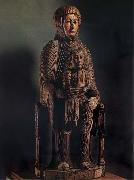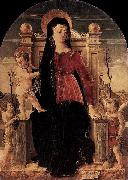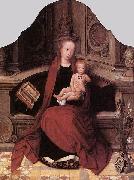Wholesale Oil Painting No Minimum |
|||||||||||
|
|
|||||||||||

|
|||||||||||
|
|
|
||||||||
|
|
||||||||
Virgin and Child Enthroned
Virgin and Child Enthroned Painting ID:: 41286 |
mk161
Polychromed oak
mk161 Polychromed oak |
|||||||
|
|
||||||||
Adriaen Isenbrant(between 1480 and 1490 - Bruges, July 1551), was a Flemish Northern Renaissance painter, who from documentary evidence was clearly a significant artist of his period, but to whom no specific works can be clearly documented. As hypothesised by art historians, he ran a large workshop specializing in religious subjects and devotional paintings, painting conservatively in the tradition of Early Netherlandish painting. He is believed by some to be the anonymous Master of the Seven Sorrows of the Virgin. Other art historians doubt that any works can be reliably attributed to him, and the number of paintings attributed to him by major museums has been in decline for many decades. There are only a few documentary records of his life, and some mentions in literature from his lifetime or soon after, but he cannot be documented as the creator of any surviving work; everything else consists of hypothesis. It is possible that he was born in Haarlem or even in Antwerp about 1490. It is not known where or with which painter he served his apprenticeship. He is named for the first time in 1510, when he came to Bruges and bought his burghership. In November of the same year he already became master in the painterse Guild of St. Luke and the goldsmithse guild of St. Elooi. He was later elected nine time a deacon (in Old Dutch : vinder) and twice the governor (in Old Dutch : gouverneur = treasurer) of the guild. Soon he had an important workshop, probably in the Korte Vlaminckstraat in Bruges. This was close to the workshop of Gerard David, at the Vlamijncbrugghe and the former workshop of Hans Memling. Bruges, at that time, was one of the richest towns in Europe. Rich traders and merchants ordered diptychs and portraits for personal use. Isenbrandt painted mainly for private clients. However, there were some paintings that were created without any particular commission. He had enough work to even put out work to other painters in Bruges, as a legal suit from 1534 by Isenbrandt against Jan van Eyck (not the famous one) for non-delivery of paintings he had ordered, demonstrates. He was also appointed the agent in Bruges of the painter Adriaan Provoost (son of Jan Provoost), who had moved to Antwerp in 1530. Contemporary sources therefore mention Isenbrandt as a famous and well-to-do painter. He married twice, the first time with Maria Grandeel, daughter of the painter Peter Grandeel. They had one child. After her death in 1537, he married again in 1547 with Clementine de Haerne. This second marriage resulted in two daughters and a son. He also had an extramarital daughter with the innkeeper Katelijne van Brandenburch (who was at the same the mistress of his friend Ambrosius Benson). When he died in 1551, he was buried alongside his first wife at the cemetery of the St. Jacob church in Bruges; his children inherited no less than four houses with surrounding property. |
||||||||
|
|
||||||||
|
|
Virgin and Child Enthroned
Virgin and Child Enthroned Painting ID:: 83193 |
Date 1510s
Medium Oil on oak panel
Dimensions Height: 77.5 cm (30.5 in). Width: 56.5 cm (22.2 in).
cjr Date 1510s Medium Oil on oak panel Dimensions Height: 77.5 cm (30.5 in). Width: 56.5 cm (22.2 in). cjr |
||||||
|
|
||||||||
Giorgio Schiavoneborn circa 1433-1504 |
||||||||
|
|
||||||||
|
|
Virgin and Child Enthroned
Virgin and Child Enthroned Painting ID:: 84107 |
Date between 1456(1456) and 1460(1460)
Medium Oil on canvas transferred from panel
Dimensions Height: 81 cm (31.9 in). Width: 57 cm (22.4 in).
cjr Date between 1456(1456) and 1460(1460) Medium Oil on canvas transferred from panel Dimensions Height: 81 cm (31.9 in). Width: 57 cm (22.4 in). cjr |
||||||
|
|
||||||||
Hans MemlingNetherlandish Northern Renaissance Painter, ca.1435-1494 Born in Seligenstadt, near Frankfurt in the Middle Rhein region, it is believed that Memling served his apprenticeship at Mainz or Cologne, and later worked in the Netherlands under Rogier van der Weyden (c. 1455?C1460). He then went to Bruges around 1465. There is an apocryphical story that he was a wounded at the Battle of Nancy, sheltered and cured by the Hospitallers at Bruges, and that to show his gratitude he refused payment for a picture he had painted for them. Memling did indeed paint for the Hospitallers, but he painted several pictures for them, in 1479 and 1480, and it is likely that he was known to his patrons of St John, prior to the Battle of Nancy. Memling is connected with military operations only in a distant sense. His name appears on a list of subscribers to the loan which was raised by Maximilian I of Austria, to defend against hostilities towards France in 1480. In 1477, when he was incorrectly claimed to have been killed, he was under contract to create an altarpiece for the gild-chapel of the booksellers of Bruges. This altarpiece, under the name of the Seven Griefs of Mary, is now in the Gallery of Turin. It is one of the fine creations of his more mature period. It is not inferior in any way to those of 1479 in the hospital of St. John, which for their part are hardly less interesting as illustrative of the master's power than The Last Judgment which can be found since the 1470s in the St. Mary's Church, Gda??sk. Critical opinion has been unanimous in assigning this altarpiece to Memling. This affirms that Memling was a resident and a skilled artist at Bruges in 1473; for the Last Judgment was undoubtedly painted and sold to a merchant at Bruges, who shipped it there on board of a vessel bound to the Mediterranean, which was captured by Danzig privateer Paul Beneke in that very year. This purchase of his pictures by an agent of the Medici demonstrates that he had a considerable reputation. |
||||||||
|
|
||||||||
|
|
Virgin and Child Enthroned
Virgin and Child Enthroned Painting ID:: 87008 |
1480s
Medium Oil on oak panel
cyf 1480s Medium Oil on oak panel cyf |
||||||
|
|
||||||||
Adriaen Isenbrant(between 1480 and 1490 - Bruges, July 1551), was a Flemish Northern Renaissance painter, who from documentary evidence was clearly a significant artist of his period, but to whom no specific works can be clearly documented. As hypothesised by art historians, he ran a large workshop specializing in religious subjects and devotional paintings, painting conservatively in the tradition of Early Netherlandish painting. He is believed by some to be the anonymous Master of the Seven Sorrows of the Virgin. Other art historians doubt that any works can be reliably attributed to him, and the number of paintings attributed to him by major museums has been in decline for many decades. There are only a few documentary records of his life, and some mentions in literature from his lifetime or soon after, but he cannot be documented as the creator of any surviving work; everything else consists of hypothesis. It is possible that he was born in Haarlem or even in Antwerp about 1490. It is not known where or with which painter he served his apprenticeship. He is named for the first time in 1510, when he came to Bruges and bought his burghership. In November of the same year he already became master in the painterse Guild of St. Luke and the goldsmithse guild of St. Elooi. He was later elected nine time a deacon (in Old Dutch : vinder) and twice the governor (in Old Dutch : gouverneur = treasurer) of the guild. Soon he had an important workshop, probably in the Korte Vlaminckstraat in Bruges. This was close to the workshop of Gerard David, at the Vlamijncbrugghe and the former workshop of Hans Memling. Bruges, at that time, was one of the richest towns in Europe. Rich traders and merchants ordered diptychs and portraits for personal use. Isenbrandt painted mainly for private clients. However, there were some paintings that were created without any particular commission. He had enough work to even put out work to other painters in Bruges, as a legal suit from 1534 by Isenbrandt against Jan van Eyck (not the famous one) for non-delivery of paintings he had ordered, demonstrates. He was also appointed the agent in Bruges of the painter Adriaan Provoost (son of Jan Provoost), who had moved to Antwerp in 1530. Contemporary sources therefore mention Isenbrandt as a famous and well-to-do painter. He married twice, the first time with Maria Grandeel, daughter of the painter Peter Grandeel. They had one child. After her death in 1537, he married again in 1547 with Clementine de Haerne. This second marriage resulted in two daughters and a son. He also had an extramarital daughter with the innkeeper Katelijne van Brandenburch (who was at the same the mistress of his friend Ambrosius Benson). When he died in 1551, he was buried alongside his first wife at the cemetery of the St. Jacob church in Bruges; his children inherited no less than four houses with surrounding property. |
||||||||
|
|
||||||||
|
|
Virgin and Child Enthroned
Virgin and Child Enthroned Painting ID:: 87299 |
1510s
Medium Oil on oak panel
cyf 1510s Medium Oil on oak panel cyf |
||||||
|
|
||||||||
Hans MemlingNetherlandish Northern Renaissance Painter, ca.1435-1494 Born in Seligenstadt, near Frankfurt in the Middle Rhein region, it is believed that Memling served his apprenticeship at Mainz or Cologne, and later worked in the Netherlands under Rogier van der Weyden (c. 1455?C1460). He then went to Bruges around 1465. There is an apocryphical story that he was a wounded at the Battle of Nancy, sheltered and cured by the Hospitallers at Bruges, and that to show his gratitude he refused payment for a picture he had painted for them. Memling did indeed paint for the Hospitallers, but he painted several pictures for them, in 1479 and 1480, and it is likely that he was known to his patrons of St John, prior to the Battle of Nancy. Memling is connected with military operations only in a distant sense. His name appears on a list of subscribers to the loan which was raised by Maximilian I of Austria, to defend against hostilities towards France in 1480. In 1477, when he was incorrectly claimed to have been killed, he was under contract to create an altarpiece for the gild-chapel of the booksellers of Bruges. This altarpiece, under the name of the Seven Griefs of Mary, is now in the Gallery of Turin. It is one of the fine creations of his more mature period. It is not inferior in any way to those of 1479 in the hospital of St. John, which for their part are hardly less interesting as illustrative of the master's power than The Last Judgment which can be found since the 1470s in the St. Mary's Church, Gda??sk. Critical opinion has been unanimous in assigning this altarpiece to Memling. This affirms that Memling was a resident and a skilled artist at Bruges in 1473; for the Last Judgment was undoubtedly painted and sold to a merchant at Bruges, who shipped it there on board of a vessel bound to the Mediterranean, which was captured by Danzig privateer Paul Beneke in that very year. This purchase of his pictures by an agent of the Medici demonstrates that he had a considerable reputation. |
||||||||
|
|
||||||||
|
|
Virgin and Child Enthroned
Virgin and Child Enthroned Painting ID:: 88040 |
1480s
Medium Oil on oak panel
cyf 1480s Medium Oil on oak panel cyf |
||||||
|
|
||||||||
|
Hans Memling Netherlandish Northern Renaissance Painter, ca.1435-1494 Born in Seligenstadt, near Frankfurt in the Middle Rhein region, it is believed that Memling served his apprenticeship at Mainz or Cologne, and later worked in the Netherlands under Rogier van der Weyden (c. 1455?C1460). He then went to Bruges around 1465. There is an apocryphical story that he was a wounded at the Battle of Nancy, sheltered and cured by the Hospitallers at Bruges, and that to show his gratitude he refused payment for a picture he had painted for them. Memling did indeed paint for the Hospitallers, but he painted several pictures for them, in 1479 and 1480, and it is likely that he was known to his patrons of St John, prior to the Battle of Nancy. Memling is connected with military operations only in a distant sense. His name appears on a list of subscribers to the loan which was raised by Maximilian I of Austria, to defend against hostilities towards France in 1480. In 1477, when he was incorrectly claimed to have been killed, he was under contract to create an altarpiece for the gild-chapel of the booksellers of Bruges. This altarpiece, under the name of the Seven Griefs of Mary, is now in the Gallery of Turin. It is one of the fine creations of his more mature period. It is not inferior in any way to those of 1479 in the hospital of St. John, which for their part are hardly less interesting as illustrative of the master's power than The Last Judgment which can be found since the 1470s in the St. Mary's Church, Gda??sk. Critical opinion has been unanimous in assigning this altarpiece to Memling. This affirms that Memling was a resident and a skilled artist at Bruges in 1473; for the Last Judgment was undoubtedly painted and sold to a merchant at Bruges, who shipped it there on board of a vessel bound to the Mediterranean, which was captured by Danzig privateer Paul Beneke in that very year. This purchase of his pictures by an agent of the Medici demonstrates that he had a considerable reputation. Virgin and Child Enthroned 1480s Medium Oil on oak panel cyf |
||||||||
|
|
||||||||
|
Prev Next
|
||||||||
|
|
||||||||
|
Related Paintings to Hans Memling :. |
||||||||
|
|
||||||||
|
CONTACT US |






